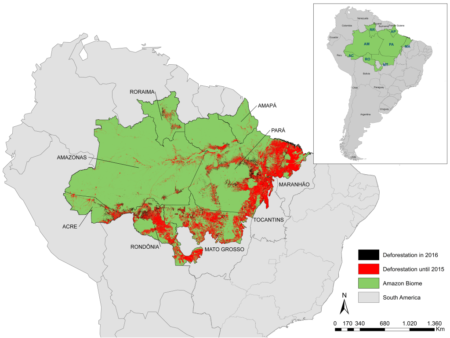August 16, 2019 – On Thursday Norway joined Germany in withdrawing money given to Brazil to protect the Amazon rainforest. To date, Norway has given more than $919 million to Brazil since 2008. Norway’s Environment Minister, Ola Elvestuen, cited the suspending of the directors and technical committee for the Amazon Fund by Brazil and its anti-climate change President, Jair Bolsonaro.
One of the great tragedies of Brazil’s recent election was the installation of Bolsonaro who, like his American equivalent, Donald Trump, doesn’t believe in anthropogenic climate change and the importance of Brazil’s rainforest as a natural carbon sink. Elvestuen noted that Bolsonaro has made it quite clear that the Amazon basin is open for business and pledging funding to allow farming, logging, and mining within it. In the month of July this year, 2,254 square kilometers (870 square miles) of the Amazon basin were cleared of forest according to Brazil’s own National Institute for Space Research. This represented a 278% increase from July 2018.
Germany has also suspended its contributions to the Brazilian rainforest protection fund citing the same reasons as Norway.
The information released by Brazil’s space research arm got a quick reaction from Bolsonaro who fired the physicist who heads it up. The government claimed that the numbers were exaggerated to embarrass Bolsonaro’s administration.
In a July 28, 2019 article published in The New York Times, Letícia Casado and But Bolsonaro sees the Amazon Basin and its forest wealth as a commercial opportunity to be exploited, and not as world’s largest land-based carbon sink worthy of preservation. Even more disturbing is the fact that much of the clearing of the Amazon is being done illegally in what may become runaway deforestation. More than 20% of Brazil’s rainforest has already disappeared.
Bolsonaro has accused the space research institute of lying and that environmentalists in Brazil and the press suffer from “environmental psychosis.” But in a recent event in São Paulo, Gerd Müller, Germany’s Minister for Economic Cooperation and Development, remarked, “Without the rainforests, there is no way to save the climate.”
The bulk of the Amazon rainforest lies within Brazil’s geographic boundaries, and it is considered a critical part of the planet’s atmospheric water cycle and according to the International Panel on Climate Change (IPCC) critical to mitigating anthropogenic climate change. The river that is the lifeblood of the rainforest rises in Peru and drains an area more than 7 million square kilometers (2.7 million square miles). The rainforest sequesters 20% of all carbon dioxide (CO2) emitted by the human burning of fossil fuels.
The rainforest also is critical to the atmospheric water cycle creating what scientists refer to as a flying river. A single rainforest tree contributes 1,000 liters (264 US gallons) of water daily to that flying river. So every tree removed represents a significant loss with geographic consequences that reach across the globe to the Indian Ocean and South Asia.
This correlation was first described in a paper published in March 2015 in the Proceedings of the National Academy of Sciences for the United States of America. The study report entitled, “Effects of large-scale deforestation on precipitation in the monsoon regions: Remote versus local effects,” described climate model simulations that demonstrated the impact of Amazon deforestation on what is known as the Intertropical Convergence Zone. The implications for the annual Indian Ocean monsoon event showed an “18% decline in precipitation over India.”
Norway and Germany have expressed their concern about the Bolsonaro government abandoning the previous commitments by Brazil to conserve the Amazon rainforest. But it should be the countries of South Asia, and India in particular, that should be raising their voices on this issue. The Indian Ocean monsoon produces between 50 and 75% of India’s annual precipitation.
















